Evaluating and Adapting Climate Change Impacts on Rice Production in Indonesia: A Case Study of the Keduang Subwatershed, Central Java
Abstract
:1. Introduction
2. Materials and Methods
2.1. Study Site
2.2. Data Collection
2.3. Climate Change Scenarios
2.4. Crop Simulation Model
2.5. Calibration and Validation of Crop Simulation Model
3. Results
3.1. Future Climate Scenarios
3.2. DSSAT Model Calibration and Validation
3.3. Future Rice Production
4. Discussion
5. Conclusions
Author Contributions
Funding
Institutional Review Board Statement
Informed Consent Statement
Data Availability Statement
Acknowledgments
Conflicts of Interest
References
- Cai, W.; Santoso, A.; Wang, G.; Yeh, S.-W.; An, S.-I.; Cobb, K.M.; Collins, M.; Guilyardi, E.; Jin, F.-F.; Kug, J.-S. ENSO and greenhouse warming. Nat. Clim. Chang. 2015, 5, 849–859. [Google Scholar] [CrossRef]
- Zhai, P.; Zhou, B.; Chen, Y. A review of climate change attribution studies. J. Meteorol. Res. 2018, 32, 671–692. [Google Scholar] [CrossRef]
- Marques, É.T.; Gunkel, G.; Sobral, M.C. Management of tropical river basins and reservoirs under water stress: Experiences from Northeast Brazil. Environments 2019, 6, 62. [Google Scholar] [CrossRef] [Green Version]
- Wild, M. Solar Radiationsurfacesolar radiationVersus Climate Changesolar radiationversus climate change. In Encyclopedia of Sustainability Science and Technology; Meyers, R.A., Ed.; Springer: New York, NY, USA, 2012; pp. 9731–9740. ISBN 978-1-4419-0851-3. [Google Scholar]
- Lehtonen, H.; Liu, X.; Purola, T. Balancing climate change mitigation and adaptation with socio-economic goals at farms in northern Europe. In Climate Change Adaptation and Food Supply Chain Management; Paloviita, A., Järvelä, M., Eds.; Routledge, Taylor & Francis Group: London, UK, 2015; Chapter 11; pp. 132–146. [Google Scholar] [CrossRef]
- Nelson, G.C.; Valin, H.; Sands, R.D.; Havlík, P.; Ahammad, H.; Deryng, D.; Elliott, J.; Fujimori, S.; Hasegawa, T.; Heyhoe, E. Climate change effects on agriculture: Economic responses to biophysical shocks. Proc. Natl. Acad. Sci. USA 2014, 111, 3274–3279. [Google Scholar] [CrossRef] [Green Version]
- Wassmann, R.; Jagadish, S.V.K.; Heuer, S.; Ismail, A.; Redona, E.; Serraj, R.; Singh, R.K.; Howell, G.; Pathak, H.; Sumfleth, K. Climate change affecting rice production: The physiological and agronomic basis for possible adaptation strategies. Adv. Agron. 2009, 101, 59–122. [Google Scholar]
- Hatfield, J.L.; Prueger, J.H. Temperature extremes: Effect on plant growth and development. Weather Clim. Extrem. 2015, 10, 4–10. [Google Scholar] [CrossRef] [Green Version]
- Pachauri, R.K.; Allen, M.R.; Barros, V.R.; Broome, J.; Cramer, W.; Christ, R.; Church, J.A.; Clarke, L.; Dahe, Q.; Dasgupta, P. Climate Change 2014: Synthesis Report. Contribution of Working Groups I, II and III to the Fifth Assessment Report of the Intergovernmental Panel on Climate Change; IPCC: Geneva, Switzerland, 2014; ISBN 9291691437. [Google Scholar]
- Morgounov, A.; Sonder, K.; Abugalieva, A.; Bhadauria, V.; Cuthbert, R.D.; Shamanin, V.; Zelenskiy, Y.; DePauw, R.M. Effect of climate change on spring wheat yields in North America and Eurasia in 1981-2015 and implications for breeding. PLoS ONE 2018, 13, e0204932. [Google Scholar] [CrossRef]
- Gentilucci, M.; D’Aprile, F. Variations in trends of temperature and its influence on tree growth in the Tuscan Apennines. Arab. J. Geosci. 2021, 14, 1–20. [Google Scholar] [CrossRef]
- Muthayya, S.; Sugimoto, J.D.; Montgomery, S.; Maberly, G.F. An overview of global rice production, supply, trade, and consumption. Ann. N. Y. Acad. Sci. 2014, 1324, 7–14. [Google Scholar] [CrossRef]
- Lal, R. Food security in a changing climate. Ecohydrol. Hydrobiol. 2013, 13, 8–21. [Google Scholar] [CrossRef]
- Tilman, D.; Balzer, C.; Hill, J.; Befort, B.L. Global food demand and the sustainable intensification of agriculture. Proc. Natl. Acad. Sci. USA 2011, 108, 20260–20264. [Google Scholar] [CrossRef] [Green Version]
- Hoang, L.; Ngoc, T.A.; Maskey, S. A robust parameter approach for estimating CERES-Rice model parameters for the Vietnam Mekong Delta. Field Crop. Res. 2016, 196, 98–111. [Google Scholar] [CrossRef]
- Gunning-Trant, C.; Sheng, Y.; Hamshere, P.; Gleeson, T.; Moir, B. What Indonesia Wants Analysis of Indonesia’s Food Demand to 2050; ABARES Res. Rep No. 15.9; Australian Bureau of Agricultural Research Economics: Canberra, Australia, 2015. [Google Scholar]
- Yuliawan, T.; Handoko, I. The Effect of Temperature Rise to Rice Crop Yield in Indonesia uses Shierary Rice Model with Geographical Information System (GIS) Feature. Procedia Environ. Sci. 2016, 33, 214–220. [Google Scholar] [CrossRef] [Green Version]
- Halder, D.; Kheroar, S.; Srivastava, R.K.; Panda, R.K. Assessment of future climate variability and potential adaptation strategies on yield of peanut and Kharif rice in eastern India. Theor. Appl. Climatol. 2020, 140, 823–838. [Google Scholar] [CrossRef]
- Food Security Council. Atlas of Indonesia: Food Securit; Ministry of Agriculture and World Food Programe: Jakarta, Indonesia, 2015; Volume 1, pp. 1–196. [Google Scholar]
- Förster, H.; Sterzel, T.; Pape, C.A.; Moneo-Lain, M.; Niemeyer, I.; Boer, R.; Kropp, J.P. Sea-level rise in Indonesia: On adaptation priorities in the agricultural sector. Reg. Environ. Chang. 2011, 11, 893–904. [Google Scholar] [CrossRef]
- Bappenas. Indonesia Adaptation Strategy: Improving Capacity to Adapt; Ministry of National Dev.Planning: Jakarta, Indonesia, 2011; Volume 1, pp. 1–39. [Google Scholar]
- Barnwal, P.; Kotani, K. Climatic impacts across agricultural crop yield distributions: An application of quantile regression on rice crops in Andhra Pradesh, India. Ecol. Econ. 2013, 87, 95–109. [Google Scholar] [CrossRef]
- Food and Agriculture Organization of The United Nations. Resources. In Guidelines: Land Evaluation for Irrigated Agriculture; Soils Bulletin 55; Food & Agriculture Organization: Rome, Italy, 1985. [Google Scholar]
- Zaman, N.K.; Abdullah, M.Y.; Othman, S.; Zaman, N.K. Growth and physiological performance of aerobic and lowland rice as affected by water stress at selected growth stages. Rice Sci. 2018, 25, 82–93. [Google Scholar] [CrossRef]
- Shrestha, S.; Chapagain, R.; Babel, M.S. Quantifying the impact of climate change on crop yield and water footprint of rice in the Nam Oon Irrigation Project, Thailand. Sci. Total Environ. 2017, 599, 689–699. [Google Scholar] [CrossRef]
- Boonwichai, S.; Shrestha, S.; Babel, M.S.; Weesakul, S.; Datta, A. Evaluation of climate change impacts and adaptation strategies on rainfed rice production in Songkhram River Basin, Thailand. Sci. Total Environ. 2019, 652, 189–201. [Google Scholar] [CrossRef] [PubMed]
- Alejo, L.A. Assessing the impacts of climate change on aerobic rice production using the DSSAT-CERES-Rice model. J. Water Clim. Chang. 2021, 12, 696–708. [Google Scholar] [CrossRef]
- Ansari, A.; Kato, T.; Fitriah, A. Simulating Streamflow Through The SWAT Model in The Keduang Sub-Watershed, Wonogiri Regency, Indonesia. agriTECH 2019, 39, 60–69. [Google Scholar]
- Mavromatis, T.; Hansen, J.W. Interannual variability characteristics and simulated crop response of four stochastic weather generators. Agric. For. Meteorol. 2001, 109, 283–296. [Google Scholar] [CrossRef]
- Jones, P.G.; Thornton, P.K. The potential impacts of climate change on maize production in Africa and Latin America in 2055. Glob. Environ. Chang. 2003, 13, 51–59. [Google Scholar] [CrossRef]
- Thornton, P.K.; Jones, P.G.; Alagarswamy, G.; Andresen, J. Spatial variation of crop yield response to climate change in East Africa. Glob. Environ. Chang. 2009, 19, 54–65. [Google Scholar] [CrossRef]
- Claessens, L.; Antle, J.M.; Stoorvogel, J.J.; Valdivia, R.O.; Thornton, P.K.; Herrero, M. A method for evaluating climate change adaptation strategies for small-scale farmers using survey, experimental and modeled data. Agric. Syst. 2012, 111, 85–95. [Google Scholar] [CrossRef] [Green Version]
- Jones, P.G.; Thornton, P.K. Generating downscaled weather data from a suite of climate models for agricultural modelling applications. Agric. Syst. 2013, 114, 1–5. [Google Scholar] [CrossRef]
- Van Wart, J.; Grassini, P.; Yang, H.; Claessens, L.; Jarvis, A.; Cassman, K.G. Creating long-term weather data from thin air for crop simulation modeling. Agric. For. Meteorol. 2015, 209–210, 49–58. [Google Scholar] [CrossRef]
- Hoogenboom, G.; Porter, C.H.; Shelia, V.; Boote, K.J.; Singh, U.; White, J.W.; Hunt, L.A.; Ogoshi, R.; Lizaso, J.I.; Koo, J.; et al. Decision Support System for Agrotechnology Transfer (DSSAT); Version 4.7.5; DSSAT Foundation: Gainesville, FL, USA, 2019; Available online: https://DSSAT.net (accessed on 25 October 2021).
- Jones, J.W.; Hoogenboom, G.; Porter, C.H.; Boote, K.J.; Batchelor, W.D.; Hunt, L.A.; Wilkens, P.W.; Singh, U.; Gijsman, A.J.; Ritchie, J.T. The DSSAT cropping system model. Eur. J. Agron. 2003, 18, 235–265. [Google Scholar] [CrossRef]
- Hoogenboom, G.; Porter, C.H.; Boote, K.J.; Shelia, V.; Wilkens, P.W.; Singh, U.; White, J.W.; Asseng, S.; Lizaso, J.I.; Moreno, L.P. The DSSAT crop modeling ecosystem. Adv. Crop Model Sustain. Agric. 2019, 173–216. [Google Scholar] [CrossRef]
- Buddhaboon, C.; Jintrawet, A.; Hoogenboom, G. Methodology to estimate rice genetic coefficients for the CSM-CERES-Rice model using GENCALC and GLUE genetic coefficient estimators. J. Agric. Sci. 2018, 156, 482–492. [Google Scholar] [CrossRef]
- Trotochaud, J.; Flanagan, D.C.; Engel, B.A. A simple technique for obtaining future climate data inputs for natural resource models. Appl. Eng. Agric. 2016, 32, 371–381. [Google Scholar]
- Moriasi, D.N.; Arnold, J.G.; Van Liew, M.W.; Bingner, R.L.; Harmel, R.D.; Veith, T.L. Model evaluation guidelines for systematic quantification of accuracy in watershed simulations. Trans. ASABE 2007, 50, 885–900. [Google Scholar] [CrossRef]
- Tomlinson, I. Doubling food production to feed the 9 billion: A critical perspective on a key discourse of food security in the UK. J. Rural Stud. 2013, 29, 81–90. [Google Scholar] [CrossRef]
- Choudhary, J.S.; Mali, S.S.; Mukherjee, D.; Kumari, A.; Moanaro, L.; Rao, M.S.; Das, B.; Singh, A.K.; Bhatt, B.P. Spatio-temporal temperature variations in MarkSim multimodel data and their impact on voltinism of fruit fly, Bactrocera species on mango. Sci. Rep. 2019, 9, 1–12. [Google Scholar] [CrossRef] [PubMed] [Green Version]
- Bregaglio, S.; Hossard, L.; Cappelli, G.; Resmond, R.; Bocchi, S.; Barbier, J.-M.; Ruget, F.; Delmotte, S. Identifying trends and associated uncertainties in potential rice production under climate change in Mediterranean areas. Agric. For. Meteorol. 2017, 237, 219–232. [Google Scholar] [CrossRef]
- Prabnakorn, S.; Maskey, S.; Suryadi, F.X.; de Fraiture, C. Rice yield in response to climate trends and drought index in the Mun River Basin, Thailand. Sci. Total Environ. 2018, 621, 108–119. [Google Scholar] [CrossRef]
- Boonwichai, S.; Shrestha, S.; Babel, M.S.; Weesakul, S.; Datta, A. Climate change impacts on irrigation water requirement, crop water productivity and rice yield in the Songkhram River Basin, Thailand. J. Clean. Prod. 2018, 198, 1157–1164. [Google Scholar] [CrossRef]
- Van Oort, P.A.J.; Zwart, S.J. Impacts of climate change on rice production in Africa and causes of simulated yield changes. Glob. Chang. Biol. 2018, 24, 1029–1045. [Google Scholar] [CrossRef] [Green Version]
- Gupta, R.; Mishra, A. Climate change induced impact and uncertainty of rice yield of agro-ecological zones of India. Agric. Syst. 2019, 173, 1–11. [Google Scholar] [CrossRef]
- Sloat, L.L.; Davis, S.J.; Gerber, J.S.; Moore, F.C.; Ray, D.K.; West, P.C.; Mueller, N.D. Climate adaptation by crop migration. Nat. Commun. 2020, 11, 1–9. [Google Scholar] [CrossRef] [Green Version]
- Moss, R.H.; Edmonds, J.A.; Hibbard, K.A.; Manning, M.R.; Rose, S.K.; Van Vuuren, D.P.; Carter, T.R.; Emori, S.; Kainuma, M.; Kram, T. The next generation of scenarios for climate change research and assessment. Nature 2010, 463, 747–756. [Google Scholar] [CrossRef]
- Masutomi, Y.; Takahashi, K.; Harasawa, H.; Matsuoka, Y. Impact assessment of climate change on rice production in Asia in comprehensive consideration of process/parameter uncertainty in general circulation models. Agric. Ecosyst. Environ. 2009, 131, 281–291. [Google Scholar] [CrossRef]
- Gosling, S.N.; Dunn, R.; Carrol, F.; Christidis, N.; Fullwood, J.; de Gusmao, D.; Golding, N.; Good, L.; Hall, T.; Kendon, L.; et al. Climate: Observations, Projections and Impacts; MetOffice. Nottingham ePrints: Nottingham, UK, 2011; Volume 1, pp. 1–147. [Google Scholar]
- Ministry of Foreign Affairs of the Netherlands. Climate Change Profile: Indonesia; Ministry of Foreign Affairs of the Netherlands: The Hague, The Netherlands, 2018; Volume 14. [Google Scholar]
- Boer, R.; Faqih, A.; Naylor, R.L.; Battisti, D.S.; Vimont, D.J.; Falcon, W.P.; Burke, M.B. Current and Future Rainfall Variability in Indonesia; An Integrated Assessment of Climate Change Impacts, Adaptation and Vulnerability in Watershed Areas and Communities in Southeast Asia. Report from AIACC Project No AS21; Int. START Secr: Washington, DC, USA, 2004; Volume 104, p. 47. [Google Scholar]
- King, A.D.; van Oldenborgh, G.J.; Karoly, D.J. 22. Climate change and el niño increase likelihood of indonesian heat and drought. Bull. Am. Meteorol. Soc. 2016, 97, S113–S117. [Google Scholar] [CrossRef]
- Setiawan, A.M.; Lee, W.S.; Rhee, J. Spatio-temporal characteristics of Indonesian drought related to El Niño events and its predictability using the multi-model ensemble. Int. J. Climatol. 2017, 37, 4700–4719. [Google Scholar] [CrossRef]
- Das, H.P.; Adamenko, T.I.; Anaman, K.A.; Gommes, R.G.; Johnson, G. Agrometeorology Related to Extreme Events; Technical Note 201; WMO, No 943; WMO: Geneva, Switzerland, 2003; p. 152. ISBN 9263109435. [Google Scholar]
- Candradijaya, A.; Kusmana, C.; Syaukat, Y.; Syaufina, L.; Faqih, A. Climate change impact on rice yield and adaptation response of local farmers in Sumedang District, West Java, Indonesia. Int. J. Ecosyst. 2014, 4, 212–223. [Google Scholar]
- Zhang, H.; Zhou, G.; Liu, D.L.; Wang, B.; Xiao, D.; He, L. Climate-associated rice yield change in the Northeast China Plain: A simulation analysis based on CMIP5 multi-model ensemble projection. Sci. Total Environ. 2019, 666, 126–138. [Google Scholar] [CrossRef]
- Turral, H.; Burke, J.; Faurès, J.-M. Climate Change, Water and Food Security; FAO Water Report No. 36; Food and Agriculture Organization of the United Nations: Rome, Italy, 2011; ISBN 9251067953. Available online: http://go.nature.com/FSSnjq (accessed on 25 October 2021).
- Dharmarathna, W.; Herath, S.; Weerakoon, S.B. Changing the planting date as a climate change adaptation strategy for rice production in Kurunegala district, Sri Lanka. Sustain. Sci. 2014, 9, 103–111. [Google Scholar] [CrossRef]
- Parry, M.L. Assessment of Potential Effects and Adaptations for Climate Change in Europe: Summary and Conclusions; Jackson Environment Institute, University of East Anglia: Norwich, UK, 2000. [Google Scholar]
- Babel, M.S.; Turyatunga, E. Evaluation of climate change impacts and adaptation measures for maize cultivation in the western Uganda agro-ecological zone. Theor. Appl. Climatol. 2015, 119, 239–254. [Google Scholar] [CrossRef]
- Rosenzweig, C.; Tubiello, F.N. Adaptation and mitigation strategies in agriculture: An analysis of potential synergies. Mitig. Adapt. Strateg. Glob. Chang. 2007, 12, 855–873. [Google Scholar] [CrossRef] [Green Version]
- Chopin, P.; Sierra, J. Reduced tillage and organic amendments can offset the negative impact of climate change on soil carbon: A regional modelling study in the Caribbean. Soil Tillage Res. 2019, 192, 113–120. [Google Scholar] [CrossRef]
- Bryan, E.; Deressa, T.T.; Gbetibouo, G.A.; Ringler, C. Adaptation to climate change in Ethiopia and South Africa: Options and constraints. Environ. Sci. Policy 2009, 12, 413–426. [Google Scholar] [CrossRef]
- Tao, F.; Zhang, Z. Adaptation of maize production to climate change in North China Plain: Quantify the relative contributions of adaptation options. Eur. J. Agron. 2010, 33, 103–116. [Google Scholar] [CrossRef]
- Apriyana, Y.; Surmaini, E.; Estiningtyas, W.; Pramudia, A.; Ramadhani, F.; Suciantini, S.; Susanti, E.; Purnamayani, R.; Syahbuddin, H. The Integrated Cropping Calendar Information System: A Coping Mechanism to Climate Variability for Sustainable Agriculture in Indonesia. Sustainability 2021, 13, 6495. [Google Scholar] [CrossRef]
- Guo, J.; Hu, X.; Gao, L.; Xie, K.; Ling, N.; Shen, Q.; Hu, S.; Guo, S. The rice production practices of high yield and high nitrogen use efficiency in Jiangsu, China. Sci. Rep. 2017, 7, 1–10. [Google Scholar] [CrossRef] [PubMed]
- Li, Z.; Zhang, R.; Xia, S.; Wang, L.; Liu, C.; Zhang, R.; Fan, Z.; Chen, F.; Liu, Y. Interactions between N, P and K fertilizers affect the environment and the yield and quality of satsumas. Glob. Ecol. Conserv. 2019, 19, e00663. [Google Scholar] [CrossRef]
- Alley, M.M.; Vanlauwe, B. The Role of Fertilizers in Integrated Plant Nutrient Management. In International Fertilizer Industry Association, 1st ed.; IFA: Paris, France; TSBF-CIAT: Nairobi, Kenya, 2009; ISBN 2952313946. [Google Scholar]
- Chauhan, B.S.; Jabran, K.; Mahajan, G. Rice Production Worldwide; Springer: Berlin, Germany, 2017; Volume 247. [Google Scholar]
- Saptutyningsih, E.; Diswandi, D.; Jaung, W. Does social capital matter in climate change adaptation? A lesson from agricultural sector in Yogyakarta, Indonesia. Land Use Policy 2020, 95, 104189. [Google Scholar] [CrossRef]
- Akrofi, M.M.; Antwi, S.H.; Gumbo, J.R. Students in climate action: A study of some influential factors and implications of knowledge gaps in Africa. Environments 2019, 6, 12. [Google Scholar] [CrossRef] [Green Version]
- Roesch-McNally, G.E. US Inland Pacific Northwest wheat farmers’ perceived risks: Motivating intentions to adapt to climate change? Environments 2018, 5, 49. [Google Scholar] [CrossRef] [Green Version]
- Ota, L.; Herbohn, J.; Gregorio, N.; Harrison, S. Reforestation and smallholder livelihoods in the humid tropics. Land Use Policy 2020, 92, 104455. [Google Scholar] [CrossRef]
- Sharma, S.; Dhaliwal, S.S. Conservation agriculture based practices enhanced micronutrients transformation in earthworm cast soil under rice-wheat cropping system. Ecol. Eng. 2021, 163, 106195. [Google Scholar] [CrossRef]
- Li, M.; Li, H.; Fu, Q.; Liu, D.; Yu, L.; Li, T. Approach for optimizing the water-land-food-energy nexus in agroforestry systems under climate change. Agric. Syst. 2021, 192, 103201. [Google Scholar] [CrossRef]
- Suh, J. Theory and reality of integrated rice—Duck farming in Asian developing countries: A systematic review and SWOT analysis. Agric. Syst. 2014, 125, 74–81. [Google Scholar] [CrossRef]
- Chen, S.; Liu, S.; Zheng, X.; Yin, M.; Chu, G.; Xu, C.; Yan, J.; Chen, L.; Wang, D.; Zhang, X. Effect of various crop rotations on rice yield and nitrogen use efficiency in paddy–upland systems in southeastern China. Crop J. 2018, 6, 576–588. [Google Scholar] [CrossRef]
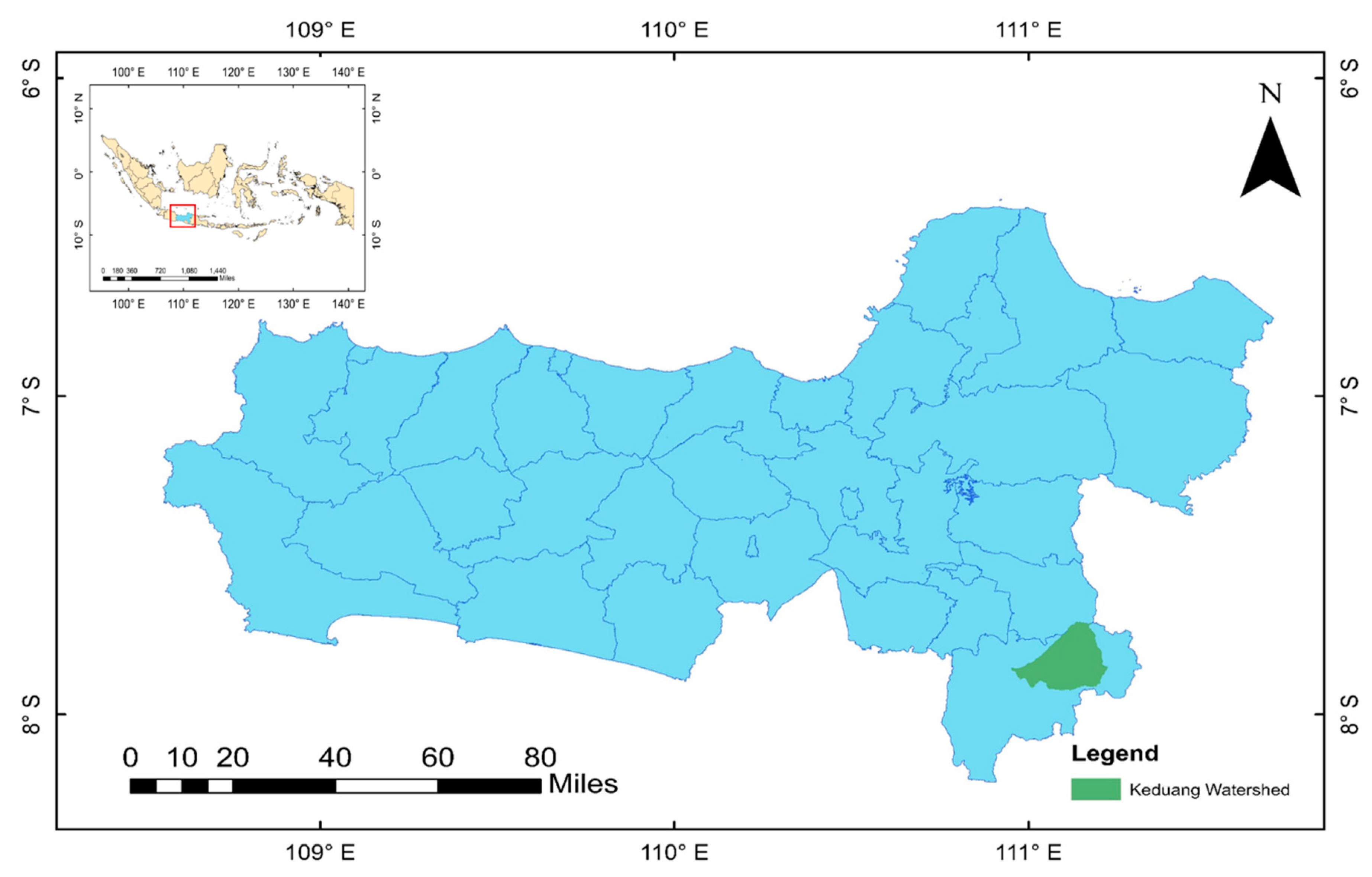
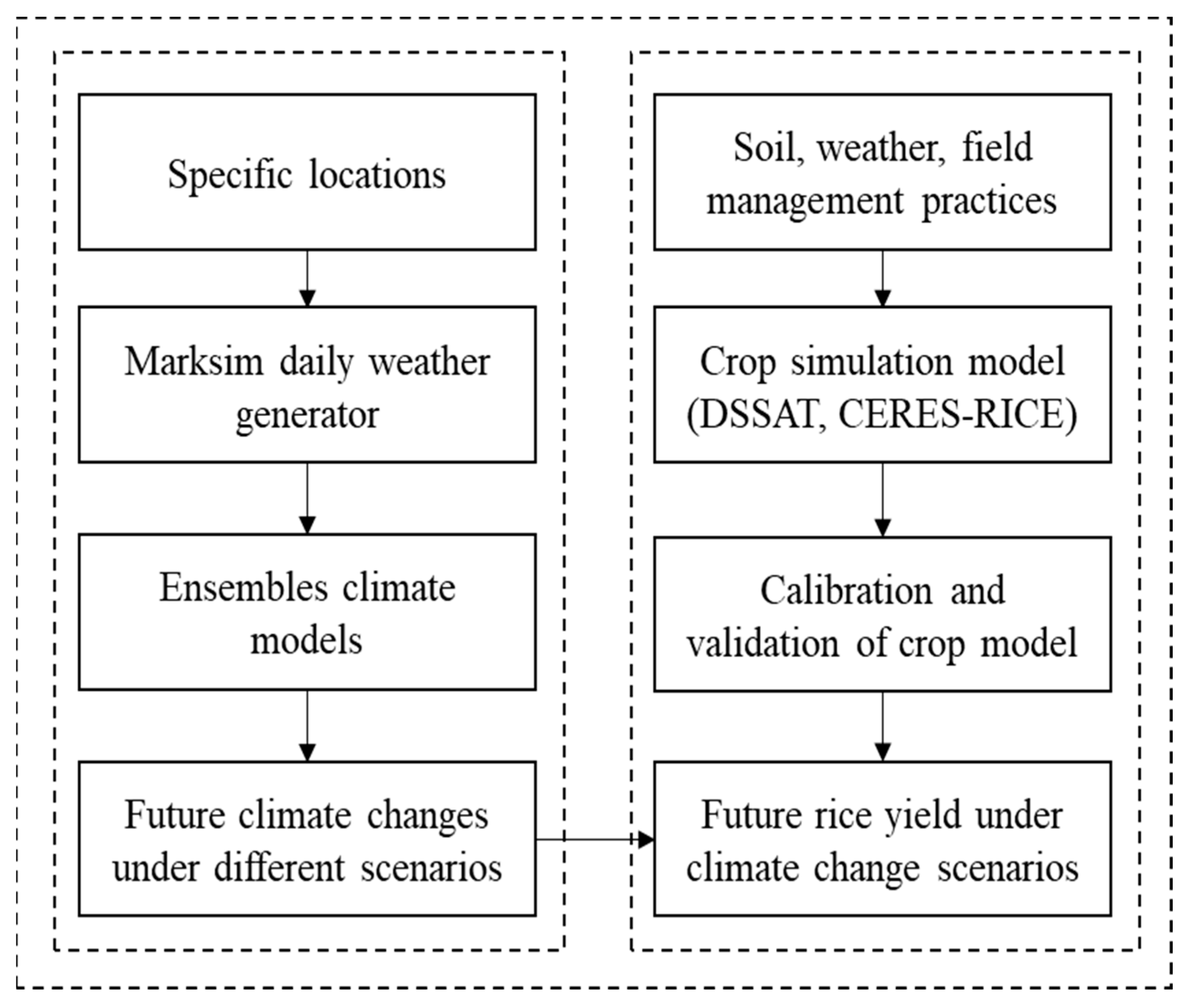
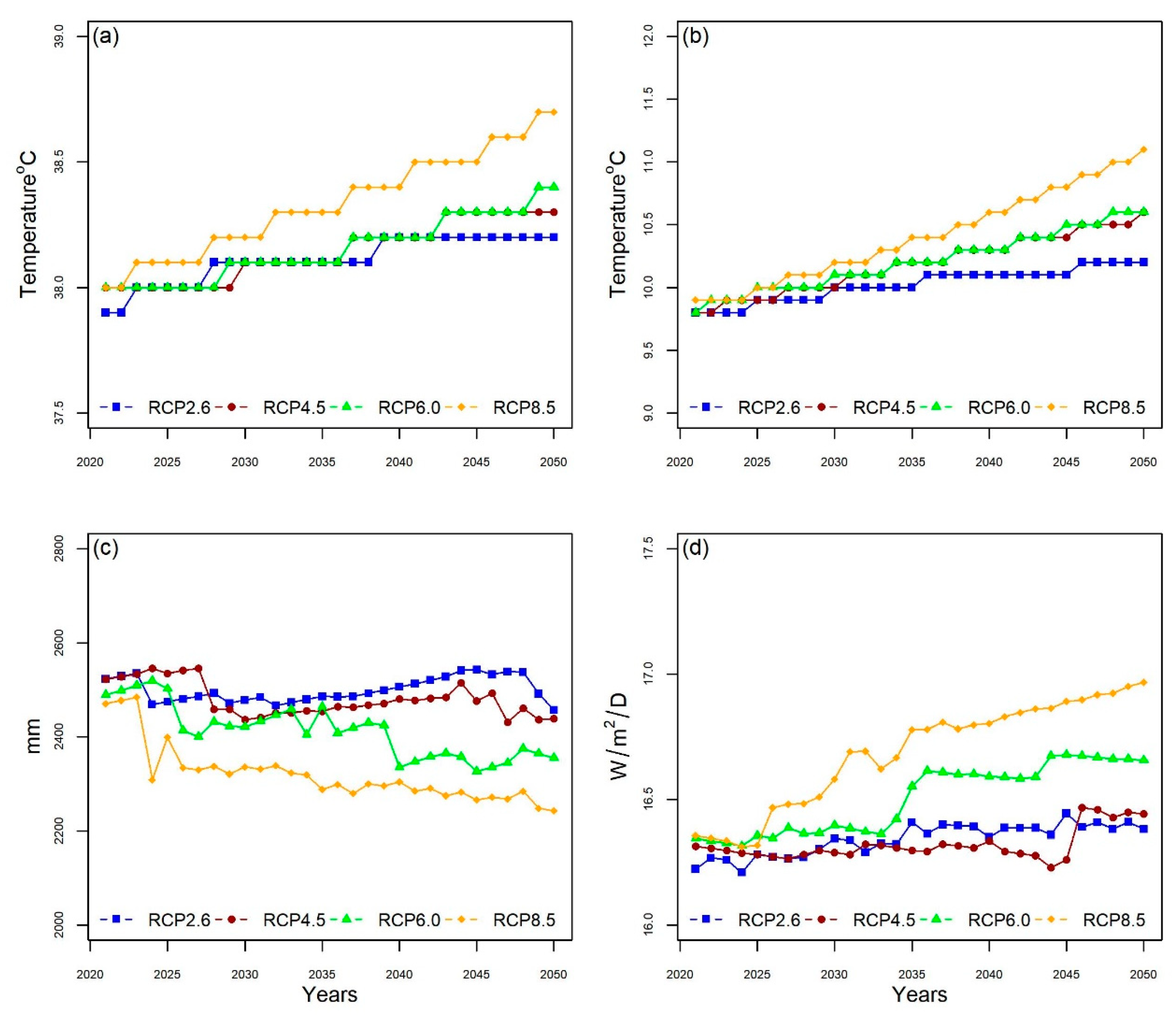
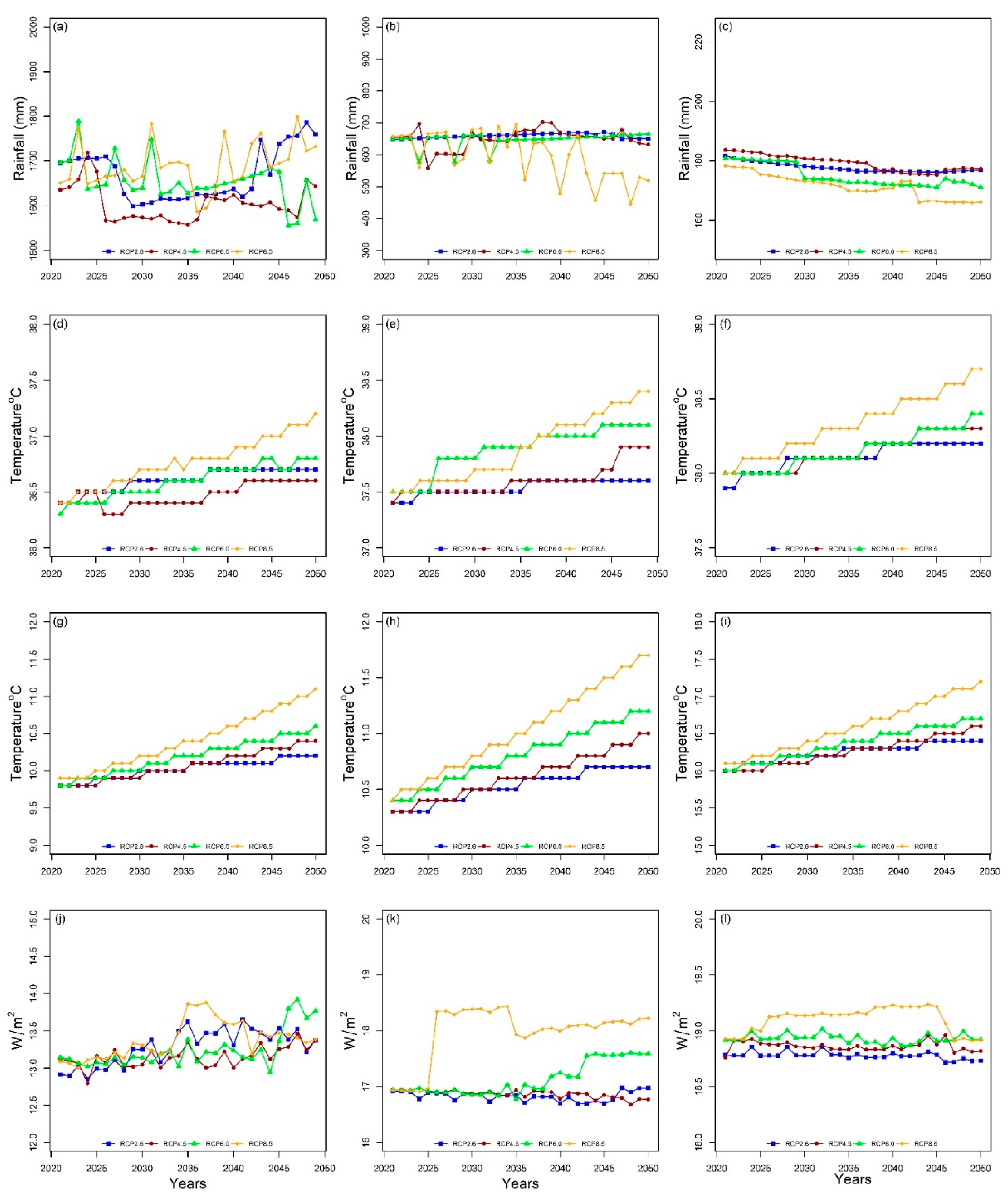
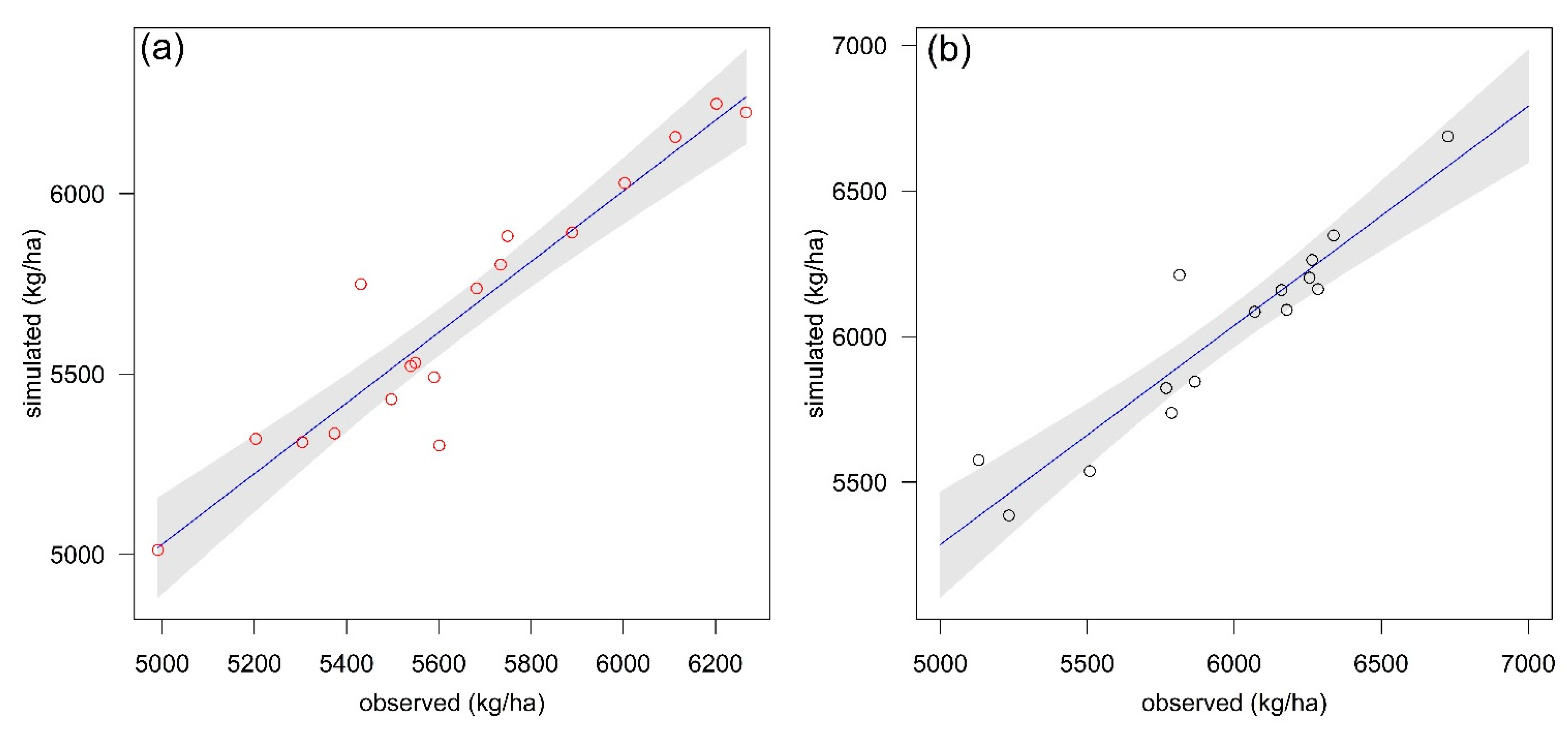
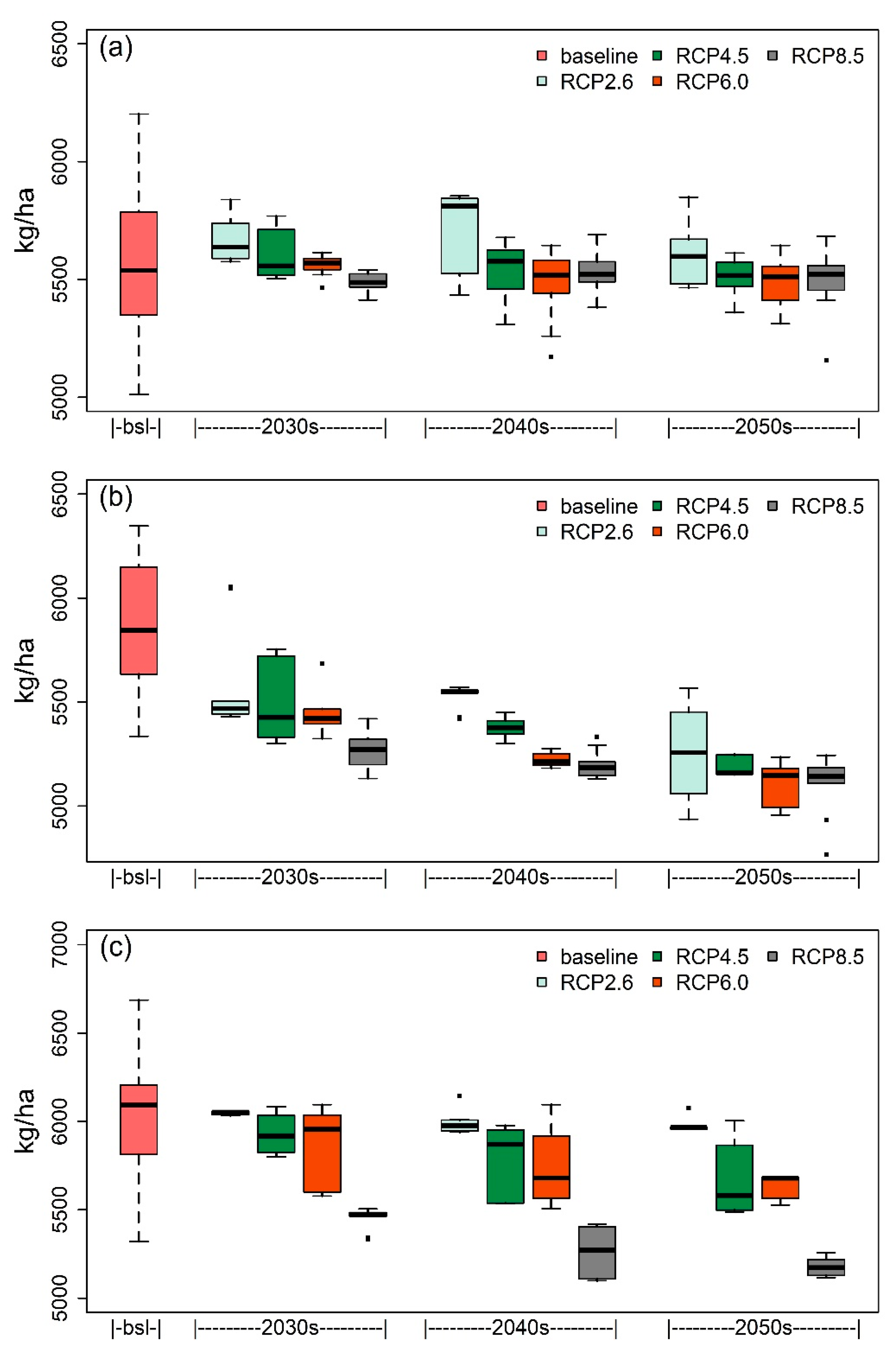
| Parameter | Definition | Range |
|---|---|---|
| Phenology genetic coefficients | ||
| P1 | The time from seedling to emergence in °C (more than 9 °C from base temperature), during which rice will not respond to changes in photoperiod. (unit: GDD) | 100–900 |
| P2O | Crucial photoperiod or the longest day length when peak development occurs (unit: h) | 10–14 |
| P2R | The sensitive extent of each hour increase in photoperiod (>P2O) to delay phasic development causing panicle initiation. (unit: GDD) | 20–600 |
| P5 | The time from the beginning of grain filling to physiological maturity, which is >9 °C from the base temperature (unit: GDD) | 100–900 |
| Growth genetic coefficients | ||
| G1 | The potential maximum spikelet number coefficient per g of main culm dry weight (unit: spikelets per g of main culm) | 35–80 |
| G2 | The weight of a single grain under suitable growing conditions (unit: g) | 0.02–0.04 |
| G3 | Scalar vegetative growth coefficient for tillering coefficients relative to IR64 | 0.6–1.2 |
| G4 | The coefficient of temperature scalar. The value is equal to 1 for varieties grown in normal conditions, >1 for varieties grown in warmer conditions, and <1 for varieties grown in cold conditions. | 0.6–1.2 |
| Parameter | Value |
|---|---|
| P1 | 388.3 |
| P2R | 137.7 |
| P5 | 408.3 |
| P2O | 12.31 |
| G1 | 74.2 |
| G2 | 0.027 |
| G3 | 1.198 |
| G4 | 1 |
| Period | Year | Rice Yield (kg/ha) | R2 | NSE | PBIAS | RMSE (kg/ha) | D-Index | |
|---|---|---|---|---|---|---|---|---|
| Observation | Simulation | |||||||
| Calibration | 2007–2012 | 5665.39 | 5650.94 | 0.89 | 0.88 | −0.3 | 115.52 | 0.97 |
| Validation | 2013–2017 | 5949.40 | 6007.73 | 0.87 | 0.76 | −1.8 | 165.85 | 0.95 |
| Policies | Adaptation Strategies |
|---|---|
| Preserving the balance of ecosystems and diversity and the existence of natural resources as a life support |
|
| Applying appropriate technologies |
|
| Modernization of irrigation systems |
|
| Crop weather insurance |
|
Publisher’s Note: MDPI stays neutral with regard to jurisdictional claims in published maps and institutional affiliations. |
© 2021 by the authors. Licensee MDPI, Basel, Switzerland. This article is an open access article distributed under the terms and conditions of the Creative Commons Attribution (CC BY) license (https://creativecommons.org/licenses/by/4.0/).
Share and Cite
Ansari, A.; Lin, Y.-P.; Lur, H.-S. Evaluating and Adapting Climate Change Impacts on Rice Production in Indonesia: A Case Study of the Keduang Subwatershed, Central Java. Environments 2021, 8, 117. https://doi.org/10.3390/environments8110117
Ansari A, Lin Y-P, Lur H-S. Evaluating and Adapting Climate Change Impacts on Rice Production in Indonesia: A Case Study of the Keduang Subwatershed, Central Java. Environments. 2021; 8(11):117. https://doi.org/10.3390/environments8110117
Chicago/Turabian StyleAnsari, Andrianto, Yu-Pin Lin, and Huu-Sheng Lur. 2021. "Evaluating and Adapting Climate Change Impacts on Rice Production in Indonesia: A Case Study of the Keduang Subwatershed, Central Java" Environments 8, no. 11: 117. https://doi.org/10.3390/environments8110117
APA StyleAnsari, A., Lin, Y.-P., & Lur, H.-S. (2021). Evaluating and Adapting Climate Change Impacts on Rice Production in Indonesia: A Case Study of the Keduang Subwatershed, Central Java. Environments, 8(11), 117. https://doi.org/10.3390/environments8110117







